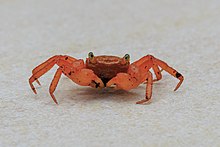Geosesarma
| Geosesarma | |
|---|---|

| |
| Geosesarma aurantium | |
| Scientific classification | |
| Domain: | Eukaryota |
| Kingdom: | Animalia |
| Phylum: | Arthropoda |
| Class: | Malacostraca |
| Order: | Decapoda |
| Suborder: | Pleocyemata |
| Infraorder: | Brachyura |
| Family: | Sesarmidae |
| Genus: | Geosesarma De Man, 1892 |
| Type species | |
| Sesarma noduliferum [1] de Man, 1892
| |
Geosesarma is genus of small freshwater or terrestrial crabs, typically less than 10 mm (0.4 in) across the carapace.[2] They live and reproduce on land with the larval stages inside the egg. They are found from India,[3] through Southeast Asia, to the Solomon Islands and Hawaii.[2]
In the pet trade, they are sometimes called vampire crabs. This has nothing to do with their feeding habits, but rather with the bright, contrastingly yellow eyes of some Geosesarma species.[4]
Species
Geosesarma contains these species:[1]
- Geosesarma aedituens Naruse & Jaafar, 2009
- Geosesarma albomita Yeo & Ng, 1999
- Geosesarma amphinome (De Man, 1899)
- Geosesarma angustifrons (A. Milne-Edwards, 1869)
- Geosesarma araneum (Nobili, 1899)
- Geosesarma aurantium Ng, 1995
- Geosesarma bau Ng & Jongkar, 2004
- Geosesarma bicolor Ng & Davie, 1995
- Geosesarma bintan T. M. Leong, 2014
- Geosesarma cataracta Ng, 1986
- Geosesarma celebense (Schenkel, 1902)
- Geosesarma clavicrure (Schenkel, 1902)
- Geosesarma confertum (Ortmann, 1894)
- Geosesarma danumense Ng, 2003
- Geosesarma dennerle Ng, Schubart & Lukhaup, 2015
- Geosesarma foxi (Kemp, 1918)
- Geosesarma gordonae (Serène, 1968)
- Geosesarma gracillimum (De Man, 1902)
- Geosesarma hagen Ng, Schubart & Lukhaup, 2015
- Geosesarma hednon Ng, Liu & Schubart, 2003
- Geosesarma ianthina Pretzmann, 1985
- Geosesarma insulare Ng, 1986
- Geosesarma johnsoni (Serène, 1968)
- Geosesarma katibas Ng, 1995
- Geosesarma krathing Ng & Naiyanetr, 1992
- Geosesarma larsi Ng & Grinang, 2018
- Geosesarma lawrencei Manuel-Santos & Yeo, 2007
- Geosesarma leprosum (Schenkel, 1902)
- Geosesarma maculatum (De Man, 1892)
- Geosesarma malayanum Ng & Lim, 1986
- Geosesarma nannophyes (De Man, 1885)
- Geosesarma nemesis Ng, 1986
- Geosesarma noduliferum (De Man, 1892)
- Geosesarma notophorum Ng & C. G. S. Tan, 1995
- Geosesarma ocypodum (Nobili, 1899)
- Geosesarma penangense (Tweedie, 1940)
- Geosesarma peraccae (Nobili, 1903)
- Geosesarma protos Ng & Takeda, 1992
- Geosesarma rathbunae (Serène, 1968)
- Geosesarma rouxi (Serène, 1968)
- Geosesarma sabanum Ng, 1992
- Geosesarma sarawakense (Serène, 1968)
- Geosesarma scandens Ng, 1986
- Geosesarma serenei Ng, 1986
- Geosesarma solomonense (Serène, 1968)
- Geosesarma starmuhlneri Pretzmann, 1984
- Geosesarma sumatraense Ng, 1986
- Geosesarma sylvicola (De Man, 1892)
- Geosesarma ternatense (Serène, 1968)
- Geosesarma teschi Ng, 1986
- Geosesarma thelxinoe (De Man, 1908)
- Geosesarma tiomanicum Ng, 1986
- Geosesarma vicentense (Rathbun, 1914)
As of March 2015, professor Peter Ng of National University of Singapore has named 20 Geosesarma species, and he "has another half a dozen or so newly collected Geosesarma species from Southeast Asia in his lab, and these species still need to be named and described."[4][5]
Threats
Geosesarma dennerle and Geosesarma hagen, both originally from Java, are threatened by illegal overcollection for the aquarium trade.[6]
References
- ^ a b Peter Davie (2012). "Geosesarma de Man, 1892". WoRMS. World Register of Marine Species. Retrieved November 8, 2012.
- ^ a b Hartnoll, Richard G. (1998). "Evolution, systematics, and geographical distribution". In Warren W. Burggren; Brian R. McMahon (eds.). Biology of the Land Crabs. Cambridge University Press. pp. 6–54. ISBN 9780521306904.
- ^ Pati, S. K.; Dev Roy, M. K.; Sharma, R. M. "Freshwater crabs" (PDF). Checklist of Indian fauna. Zoological Survey of India. Archived from the original (PDF) on September 17, 2013. Retrieved November 8, 2012.
- ^ a b Blaszczak-Boxe, Agata (March 19, 2015). "Mystery of the 'Vampire Crabs' Solved". livescience.com.
- ^ Blaszczak-Boxe, Agata (19 March 2015). "Mystery of the 'Vampire Crabs' Solved". LiveScience. Retrieved 2021-02-11.
- ^ Mahbu, Amri (March 23, 2015). "New Species of Javan Vampire Crabs Face Potential Exploitation".
External links
 Data related to Geosesarma at Wikispecies
Data related to Geosesarma at Wikispecies
